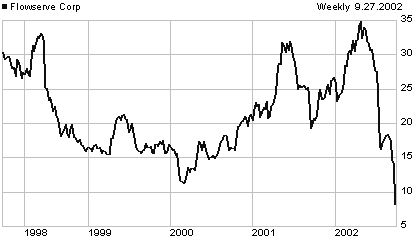 Deaths
which occurred on a 27 September: Deaths
which occurred on a 27 September:
2002 Kelvin DeBourgh, 23, 2:35 hours after the 12:25 derailment
[photo >] of three cars of the light “AirTrain”
he, alone on board, was testing, designed to link New York's John F.
Kennedy International Airport with public transport lines. DeBourgh worked
for Bombardier, the company that designed and built the train, which
it will operate.
2002 Mark Zach, 35, Nebraska State Patrol officer for twelve years,
suicide with his service revolver, at 13:00, in Norfolk, Nebraska. He
leaves behind his widow and his six orphaned children, aged 4 to 15.
On 20 September 2002, Erick Fernando Vela, 21, had been stopped by Zach,
who ticketed him for carrying a concealed weapon. Zach transposed two
digits when entering the gun's serial number into a police computer.Thus
the gun was not signaled as stolen and Vela was not arrested, though
the gun was confiscated. On 26 September Vela was one of the three men
who assaulted a bank in Norfolk, killing
five persons.
2002 Mohammed Yarmour, 21, shot at his Hebron, West Bank, home
in a predawn raid by Israeli troops who surrounded his home in the Farash
neighborhood of Hebron, West Bank. The Isralis variously say that Yarmour,
a leading Hamas activist, fired a pistol at them, and that he was killed
while fleeing armed with a submachinegun.
2002 Glen Rounds, 96, mule skinner, cowboy, carnival medicine
man, and other odd jobs, and then, for most of his life, folk author
and illustrator. His dozens of books include tall tales and realistic
stories about life and nature on the plains, particularly in Montana,
where he grew up on ranches, drawing the people, animals and daily life
he saw, and North Carolina, where he lived. Although published for children,
many of his books also appealed to adults. The first, Ol' Paul, the
Mighty Logger (1936), still in print when he died, contains 10 stories
about Paul Bunyan. The stories were made up, not researched. The 11 titles
in the "Whitey" series, about a young cowboy and his cousin, were published
from 1941 to 1963 and remained popular for years with children 7 to 10.
In 1989 severe arthritis in his right arm forced him to stop drawing.
He used the summer to learn to draw left-handed and went back to work.
The illustrations in the books of his last years, especially Sod Houses
on the Great Plains (1995) and his last, Beaver (1999), have
a distinctive rough spareness.
2001: 14 persons, by gunfire and a hand grenade, by an assailant
disguised as a police officer (one of the 14, as he shoots himself
last), in a joint meeting of the cantonal government and assembly
in Zug, Switzerland.. Three members of the local government are among
the victims.
2000 Plane hijacker, beaten to death with a mobile phone by
passengers on a Xinhua Airline Boeing 737 flying from Baotou (Inner
Mongolia). The plane landed at Jinan (Shandong). All 143 passengers
were unharmed. One pilot was hospitalized.
1997 William
Edge, mathematician.
1996 Najibullah, former Afghan president, hanged by Taliban.
Near the end of the eight years of factional conflict that plagued
Afghanistan following the Soviet withdrawal, Taliban, a group of Islamic
fundamentalists, seized control of Kabul, the capital of Afghanistan,
and hang Najibullah, the former Afghan president. By mid 1997, all
of Afghanistan was under the control of Taliban, who enforced strict
Islamic law across the nation.
1994: 40 personas mueren y otras 70 resultan heridas al estallar
una bomba durante una boda en una casa de Kabul (Afganistán).
1994 Carlos Lleras Restrepo, ex presidente de Colombia.
1986 Cerca de 25'000 aves, en su mayoría patos, mueren en las
marismas limítrofes con el Parque Nacional de Doñana, envenenadas
por el supuesto uso indiscriminado de insecticidas.
1975 Dos miembros de ETA y tres del FRAP, fusilados en España
por terrorismo.
1962 Francisco Brochado da Rocha, 52, PM of Brazil (1962)
1961 Josep María de Sagarra, escritor español.
1960 Sylvia Pankhurst, 78, British
suffragette and international socialist, in Addis
Ababa. ^top^
Born in Manchester, England,
in 1882, Sylvia Pankhurst was the daughter of Emmeline Pankhurst,
a champion of woman suffrage who became active in the late 1880s.
Sylvia won a scholarship to the Royal College of Art and in
London divided her time between her studies and involvement
in her mother's campaign to win women the right to vote. With
her mother and older sister — Christabel — she helped found the
Women's Social and Political Union (WSPU) in 1903, a political
organization dedicated to achieving equality between the sexes,
with an emphasis on female enfranchisement.
In 1906, she abandoned her studies
and a promising career in art to pursue politics full time.
A socialist, she believed that lower-class women would never
be liberated until they were brought out of poverty. Because
of this view, she began to drift from her more conservative
mother and sister, who were focused on the goal of woman suffrage.
Nevertheless, she remained a dedicated member of the WSPU and,
like her sister and mother, was arrested numerous times for
nonviolent protests and conducted hunger strikes. When Christabel
and other members of the WSPU began to advocate violent acts
of agitation — particularly arson — Sylvia, a pacifist, opposed
them.
In 1914, Sylvia was expelled
from the WSPU for her insistence on involving working-class
women in the suffrage movement. Emmeline and Christabel Pankhurst
felt that suffrage could best be achieved through the efforts
of middle-class women like themselves. Bringing leftist politics
into the movement, they reasoned, would only enflame the British
government. The gulf between the Pankhursts grew wider when
Emmeline and Christabel called off their suffrage campaign at
the outbreak of World War I and became adamant supporters of
the British war effort. These actions won them the admiration
of the British government, but Sylvia refused to compromise
her pacifist beliefs and took an opposite approach.
From her base in the poor East
End of London, Sylvia ran the East London Federation of the
Suffragettes (ELFS) and published a working-class women's paper,
the Woman's Dreadnought. She became regarded as a leader of
working-class men as well as women and convinced a few labor
organizations to oppose the war. Because non-agricultural male
laborers had also not yet been granted the vote, she changed
the name of the ELFS to the Workers' Suffrage Federation in
1916, and in 1917 the Woman's Dreadnought became the Workers'
Dreadnought. She corresponded with Russian revolutionary Vladimir
Lenin and in 1920 was a founding member of the Communist Party
of Great Britain (CPGB). In 1921, however, she was expelled
from the party when she refused to close the Workers' Dreadnought
in favor of a single CPGB paper. Britain granted universal male
suffrage in 1918. Soon after, women age 30 or over were guaranteed
the vote. In 1928, the voting age for women was lowered to 21,
the age that men could vote. By then, Sylvia Pankhurst had shifted
her energies to opposing racism and the rise of fascism in Europe.
In 1935, she campaigned vigorously against the invasion of Ethiopia
by Fascist Italy and founded The New Times and Ethiopia News
to publicize the plight of the Ethiopians and other victims
of fascism. She later helped settle Jewish refugees from Germany.
In 1956, Ethiopian Emperor Haile
Selassie invited her to live in Ethiopia, and she accepted the
invitation. Although in her 70s, she founded The Ethiopia
Observer and edited the paper for four years. |
1959 Nearly 5000 persons, by typhoon Vera, on Honshu.
1956 Milburn Apt in X-2 rocket plane reaches 3370 kph, but, dies
in crash
1944 Thousands of British troops are killed as German forces rebuff
their massive effort to capture the Arnhem Bridge across the Rhine River
in Holland.
1944 Aristide Maillol, escultor francés.
1940 Julián Besteiro Fernández, dirigente socialista español.
1921 Engelbert Humperdinck, compositor alemán.
1917 Edgar Degas, pintor francés.
1910 Jorge Chávez, aviador peruano, el primero que atravesó los
Alpes en avión.
1907 Sergio Camargo Pinzón, militar y político colombiano.
1905 Thomas Edgar Pemberton, author. PEMBERTON ONLINE: An
Essay for the Further Improvement of Dancing
1903 James Stanley Grimes, author. GRIMES ONLINE: Geonomy:
A Theory of the Ocean Currents and Their Agency in the Formation of the
Continents; to which is added Astrogenea: A New Theory of the Formation
of Planetary Systems
1891 Ivan Aleksandrovich Goncharov, Russian novelist and travel
writer His Oblomov
(English translation) is regarded as one of the most important Russian
novels. — GONCHAROV ONLINE: Oblomov
— Obyknovennaya
istoriya — Opyat'
“Gamlet” na russkoy stzene — (English translation):
Oblomov
1886 John Esten Cooke, author. COOKE ONLINE: The
Life of Stonewall Jackson
1869 Samuel Strawhun shot by
Sheriff Wild Bill Hickok
^top^
Just after midnight, Ellis County
Sheriff Wild Bill Hickok and his deputy respond to a report
that a local drunken ruffian named Samuel Strawhun, a teamster,
and several drunken buddies are tearing up John Bitter's Beer
Saloon in Hays City, Kansas. When Hickok arrives and orders
the men to stop, Strawhun turns to attack him, and Hickok shoots
him in the head. Strawhun died instantly, as did the riot. Such
were Wild Bill's less-than-restrained law enforcement methods.
Famous for his skill with a pistol
and steely-calm under fire, James Butler Hickok initially seemed
to be the ideal man for the sheriff of Ellis County, Kansas.
The good citizens of Hays City, the county seat, were tired
of the wild brawls and destructiveness of the hard-drinking
buffalo hunters and soldiers who took over their town every
night. They hoped the famous "Wild Bill" could restore peace
and order, and in the late summer of 1869, elected him as interim
county sheriff.
Tall, athletic, and sporting
shoulder-length hair and a sweeping mustache, Hickok cut an
impressive figure, and his reputation as a deadly shot with
either hand was often all it took to keep many potential lawbreakers
on the straight and narrow. As one visiting cowboy later recalled,
Hickok would stand "with his back to the wall, looking at everything
and everybody under his eyebrows—just like a mad old bull."
But when Hickok applied more
aggressive methods of enforcing the peace, some Hays City citizens
wondered if their new cure wasn't worse than the disease. Shortly
after becoming sheriff, Hickok shot a belligerent soldier who
resisted arrest, and the man died the next day. A few weeks
later Hickok kills Strawhun. While his brutal ways were indisputably
effective, many Hays City citizens were less than impressed
that after only five weeks in office he had already found it
necessary to kill two men in the name of preserving peace. During
the regular November election later that year, the people expressed
their displeasure, and Hickok lost to his deputy, 144-89. Though
Wild Bill Hickok would later go on to hold other law enforcement
positions in the West, his first attempt at being a sheriff
had lasted only three months. |
1864: 22 unarmed Union soldiers,
massacred by Confederate guerrillas.
^top^
THE CENTRALIA MASSACRE
is perpetrated by William “Bloody Bill” Anderson and
his henchmen, including a teenage Jesse James. They sack the
town of Centralia, Missouri, killing 22 unarmed Union soldiers
before massacring 120 pursuing Yankees.
The Civil War in Missouri and
Kansas was rarely fought between regular armies in the field.
It was carried out primarily by partisan bands of guerilla fighters,
and the atrocities were nearly unmatched. In 1863, Confederate
marauders sacked Lawrence, Kansas, and killed 250 residents.
In 1864, partisan activity increased
in anticipation of Confederate General Sterling Price's invasion
of the state. On the evening of 26 September, a band of 200
Confederate marauders gathered near the town of Centralia, Missouri.
The next morning, Anderson led 30 guerillas into Centralia and
began looting the tiny community and terrorizing the residents.
Unionist congressmen William Rollins escaped execution only
by giving a false name and hiding in a nearby hotel.
Meanwhile, a train from St. Louis
was just pulling into the station. The engineer, who spotted
Anderson's men destroying the town, tried to apply steam to
keep the train moving. However, the brakeman, unaware of the
raid, applied the brakes and brought the train to a halt. The
guerillas took 150 prisoners from the train, which included
23 Union soldiers, and then set it on fire and opened its throttle;
the flaming train sped away from the town. The soldiers were
stripped and Anderson's men began firing on them, killing all
but one within a few minutes. The surviving Yankee soldier was
spared in exchange for a member of Anderson's company who had
recently been captured.
(same day) Union Major A. V. E. Johnston and
all his 120 or so soldiers.
That afternoon, a Union detachment
commanded by Major A. V. E. Johnston arrived in Centralia to
find the bushwhackers had already vacated the town. Johnston
left some troops to hold the tiny burgh, and then headed in
the direction of Anderson's band. Little did he know he was
riding right into a perfect trap: Johnston's men followed Rebel
pickets into an open field, and the Southern partisans attacked
from three sides. Johnston and his entire command were quickly
annihilated. Anderson's men scalped and mutilated many of the
bodies before moving back into Centralia and killing the remaining
Federal soldiers. In all, the bushwhackers killed some 140 Yankee
troops.
A month later, Anderson would
be killed attempting a similar attack near Albany, Missouri.
|
1858 Jose Joaquin Vallejo, escritor chileno.
1854 Henry Hope Reed, author. REED ONLINE: For
the People
1854 Some 300 people aboard steamship Arctic which sinks.
1832 Karl Christian Friedrich Krause, filósofo alemán.
1783 Bézout,
mathematician
1674 Thomas Traherne, author. TRAHERNE ONLINE: Centuries
of Meditations
1660 St Vincent de Paul Vincentian Congregation founder After
giving his life to serving the poor, he founded the first Confraternity
of Charity in 1617, the Congregation of the Mission in 1625, and the
Daughters of Charity in 1633 (the first non-monastic women's order completely
given to care of the sick and poor). Canonized in 1737, he was named
patron saint of all charitable works in 1885.
1527 Domenico Ubaldini “Puligo”, Italian artist born
in 1492. — Portrait
of Piero Carnesecchi — Madonna
con il Bambino e San Giovannino
1290 Some 100'000 earthquake victims in Gulf of Chili, China
|
 On
a 27 September:
On
a 27 September:  FLS is downgraded by SunTrust Robinson Humphrey from Buy to Neutral,
and by Michael Schneider of Robert W. Baird from Outperform to Underperform.
On the New York Stock Exchange the stock drops from its previous close
of $14.10 to an intraday low of $7.90 and closes at $8.70. It had traded
as high as $35.09 as recently as 02 May 2002. [5~year price chart >]
FLS is downgraded by SunTrust Robinson Humphrey from Buy to Neutral,
and by Michael Schneider of Robert W. Baird from Outperform to Underperform.
On the New York Stock Exchange the stock drops from its previous close
of $14.10 to an intraday low of $7.90 and closes at $8.70. It had traded
as high as $35.09 as recently as 02 May 2002. [5~year price chart >] Deaths
Deaths